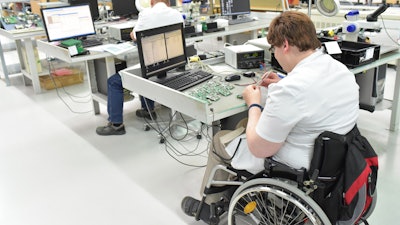
While the manufacturing industry has progressed in its recovery from the COVID-19 pandemic, 2.7 million professionals are predicted to exit the manufacturing workforce through retirement over the next 10 years. Recent studies have shown that 84% of manufacturing executives agree there is a talent shortage in U.S. manufacturing due to young professionals avoiding the industry as a career destination.
As the talent shortage continues to grow, consequences that span outside of the manufacturing landscape could become a reality for all. It is more important than ever for business leaders to respond and find talent to fill these open positions proactively.
As the world transforms and becomes increasingly more digital every day, the possibilities are endless. Now is the time for manufacturers to explore their talent and take advantage of this new, mobile workforce.
By looking into more talent pools, manufacturing leaders can tap into diverse groups that have often been passed over in the candidate pool. One such group, accounting for one in four Americans, has been overlooked far too long in the assortment of industries, especially manufacturing.
While manufacturing positions frequently involve physical labor, advancements in technology have proven that individuals with disabilities can perform these jobs. It is easier than ever for those who may be deaf or hard of hearing, blind or visually impaired or those who have mobility issues filling open positions in an industry that has typically been viewed as rigorous and even challenging. Manufacturers can now leverage technology to dive into broader talent pools by providing individuals with tools that will enable them to thrive.
Voice Picking
While not new to warehousing, voice picking has remained a crucial technology throughout the decades in bolstering employee productivity and enhancing pick accuracy, which has led to reduced operational costs and better efficiency. With the voice picking technology, warehouse employees use a headset and wearable radiofrequency device to receive verbal instruction for direction in completing various daily tasks.
An example of this is picking customer orders. In using this device, warehouse workers will receive automatic queues to use combination codes or commands to identify pick locations, quantities and details of products. Not only can the software repeat instructions on demand, but it can also log progress, interpret the worker’s response and complete work.
Although the voice picking device was not exclusively created for accessibility, nonprofit organizations like Austin Lighthouse leverage the technology to grant opportunities to their blind and visually impaired employees.
This wearable computer and headset have enabled visually impaired employees to perform on the same level as non-disabled employees by decreasing pick times and boosting overall performance in the warehouse. As a result, order fulfillment accuracy is upwards of 99% and customer satisfaction continues to endure.
Mobile Computers
Within the manufacturing or warehouse environment, mobile computers are a versatile tool in their ability to perform a variety of functions, including: inventory management, receiving and putaway activities, order picking, reporting of manufactured goods as “completed” and product returns processing.
While mobile computers are a multifaceted tool that allows for associates to obtain and finalize tasks in the palm of their hands on the warehouse floors, they are often defaulted with close-range scanning capabilities and small text.
While this can present challenges for employees who may be blind or visually impaired, modern devices can be facilitated with adaptive technology to enable the necessary modifications that suit the user’s experience.
Employees who are visually impaired can employ these personalized mobile computers to carry out daily tasks. With a variety of customizations, the most sought after tend to include both long and short-range scanners for the enablement of employees to scan labels, as well as larger and concise text on screens. Other popular customizations include the altered colors and audible messages to notify workers with error conditions that appear in red and accuracy conditions that appear in green.
The mobile devices are also created with installed handles, allowing employees to manage the device and avoid potential controlling challenges. Visually impaired employees are enabled to improve both personal and team productivity through these unique customizations, as well as being able to efficiently carry out designated tasks at hand.
Assistive Robotic Devices
Despite the beliefs of them curtailing career opportunities, robots have proven to be beneficial assets to organizations, specifically in the manufacturing space. On the shop floor in manufacturing, assistive robotic devices can be programmed to bring back carts of material from staging locations, deliver and position unrefined or semi-finished materials or direct them to picking locations. This can all be done without the need of an employee to drive the goal of enabling the robot to handle non-valued or cumbersome facets of daily tasks.
In the warehouse, associates may have to walk near eight miles each day. Robotic solutions can help mitigate the barriers of getting from place to place around the shop or warehouse floors to shorten or remove non-value-added travel.
This allows for both employees facing mobility challenges and those not facing mobility challenges to devote their time to higher-value tasks that will warrant more systematic operations and increased productivity.
In conclusion, modern technologies have opened the doors to those with disabilities across all industries to pursue unique employment opportunities that they may have otherwise never considered prior.
Manufacturing leaders can invest wisely in their accessibility technologies to reach into these untapped talent pools and spearhead efforts in diversity and inclusion. In doing so, the industry will continue to be transformed and provide individuals with disabilities the opportunity to contribute their talents.
---
Chris Femia is a Managing Vice President with Blue Horseshoe Solutions. Chris advises C-level and other top executives at a variety of companies on subjects including supply chain strategy, technology, network and operations design, inventory optimization, ERP/WMS implementation organizational change management and supply chain automation solutions. Before entering consulting in 1998, Chris worked in a variety of supply chain positions within the Fortune 100, focusing on 3PL, chemical and consumer packaged goods.























